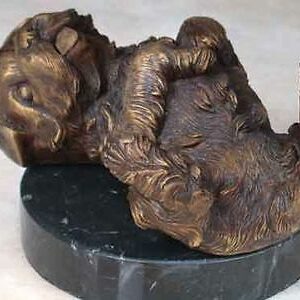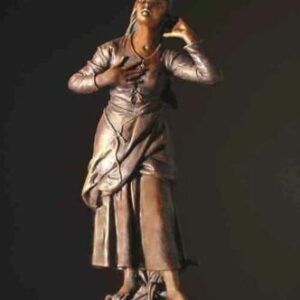Description
|
|
Elegant Art Deco Sculpture |
|
This beautiful piece is 10″ tall and weighs 5 pounds. The young lady is delicately holding a long tail love dove. She looks somewhat apprehensive as she delicately supports the dove in her outstreached hands. Her face is beautiful with a bewildered expression. The three toned antiqued patina is very well applied and looks great! This solid bronze piece is very graceful and a pleasure to view. Demetre Chiparus was born in Romania, September 16, 1886, and passed away in Dorohoi, Romania – 22 January 1947, Paris, France. He was an Art Deco era sculptor who lived and worked in Paris. He is commonly known as the Father of Art Deco. The first sculptures of Chiparus were created in the realistic style and were exhibited at the Salon of 1914. Most of his renowned works were made between 1914 and 1933. The mature style of Chiparus took shape beginning in the 1920’s. His sculptures are remarkable for their bright and outstanding decorative effect. Dancers of the Russian Ballet, French theatre, and early motion pictures were among his more notable subjects and were typified by a long, slender, stylized appearance. His work was influenced by an interest in Egypt, after Pharaoh]] Tutankhamen’s tomb was excavated. |
|
|
|
|
|
|
|
How Is It Made ? What gives bronze art value beyond that of a “souvenir” that ends up in a closet? There are many reasons including cost of materials (bronze, silicone for molds, tools, ovens, etc.) The main reason is there are very few people trained in the tedious process practiced by the ancient Greeks and Romans. Bronze sculpture is not easy to make and many time consuming, difficult steps are involved. In a world of hi-tech mass production, bronze casting remains essentially unchanged. Beware of “cold cast” or “bonded bronze”, these are misleading names given to plastic figurines. Each of our genuine bronze castings is in reality an “original” and the following explains why. These are the basic steps involved in creating a bronze Sculpture using the classic “cire perdue” (lost wax) process: • artist’s original model
The bronze must now be repaired and finished. This step is called “chasing” and it is a difficult process because the metal is involved. Any imperfection such as air pockets of pits must be brazed with bronze rod, as in welding. All seams and spurs must be removed by grinding, rasping and, finally, sanding. The next step is to chase or hammer the vents from the mold using special tools. The natural bronze has a dull finish. after final finishing, a patina is applied which may be left matte of polished. Chemicals, pigments, heat, safety equipment and a lot of experience are involved. In addition, since bronze comes in a variety of alloys, the patina requires different chemicals and techniques. Special !
Combine multiple items for discount and free ship
800-321-8618 for credit cards or if you have any questions.

_____________________________________________________________________________________________________________ Shipping Cost
|











Reviews
There are no reviews yet.